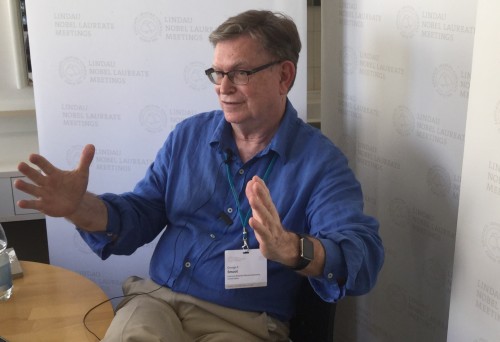
Measuring the universe: George Smoot enthuses about gravitational waves.
By Hamish Johnston at the Lindau Nobel Laureate Meeting in Germany
Yesterday I was in a fantastic session with George Smoot, who shared the 2006 Nobel Prize for Physics for discovering the anisotropy in the cosmic microwave background. He will be speaking today at the 66th Lindau Nobel Laureate Meeting about another important astronomical discovery, the first direct detection of gravitational waves that was made by LIGO in September 2015. Waves that were created by the merger of two unexpectedly large black holes.
At a session for journalists Smoot couldn’t have been more enthusiastic about the topic. He said that the detection has already told us that our current theories of stellar evolution are probably wrong and that black holes have different origins than we had expected. I touched on these points in a news story I wrote last week about the possible origins of the two black holes that created the LIGO event.
Looking further into the future, Smoot also enthused about the LISA mission, which aims to create a million-kilometre-sized interferometer in space to detect gravitational waves at much lower frequency than LIGO. One of the many things such a detector could do is observe the gravitational waves from a pair of black holes over a period of 10 years, rather than just a few seconds as LIGO does. This long-term observing would allow LISA to pinpoint the positions of gravitational-wave sources in the sky and then study them using other telescopes and even neutrino detectors.
Smoot says that gravitonal-wave astronomy has the potential to become almost as powerful as conventional astronomy, which is based on the detection of electromagnetic waves. This will lead to a much better understanding of important aspects of astronomy including the distribution of black holes, how stars form and evolve, and the nature of neutron stars. The latter should emit detectable gravitational waves when in binary systems. It might even be possible to see waves given off when a rotating neutron star has a jump in its frequency that is thought to be caused by a tearing of its crust.
The LISA mission is expected to launch in 2034 and has just passed a major milestone in the LISA Pathfinder spacecraft, which has shown that it is possible to isolate test masses in space. However, Smoot cautions that LISA is only halfway there in terms of developing technology and the next big challenge will be creating a laser system that will allow precision measurements of tiny changes in distance between spacecraft separated by one million kilometres. And then there is the thorny issue of where the money will come from. The European Space Agency and NASA have been squabbling for years and Smoot reckons that the Chinese may soon jump in with a mission of their own.
The detection of GW’s just from the merging BH’s is not enough to have the gravitational cartography of the universe, but for this, one has to gain tremendously in the detection efficiency of the detectors to be able to detect the weak GW-signals from almost everywhere in the universe.